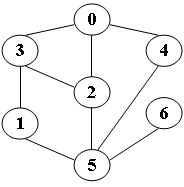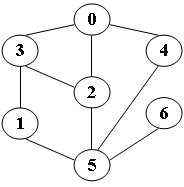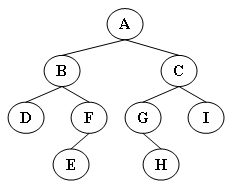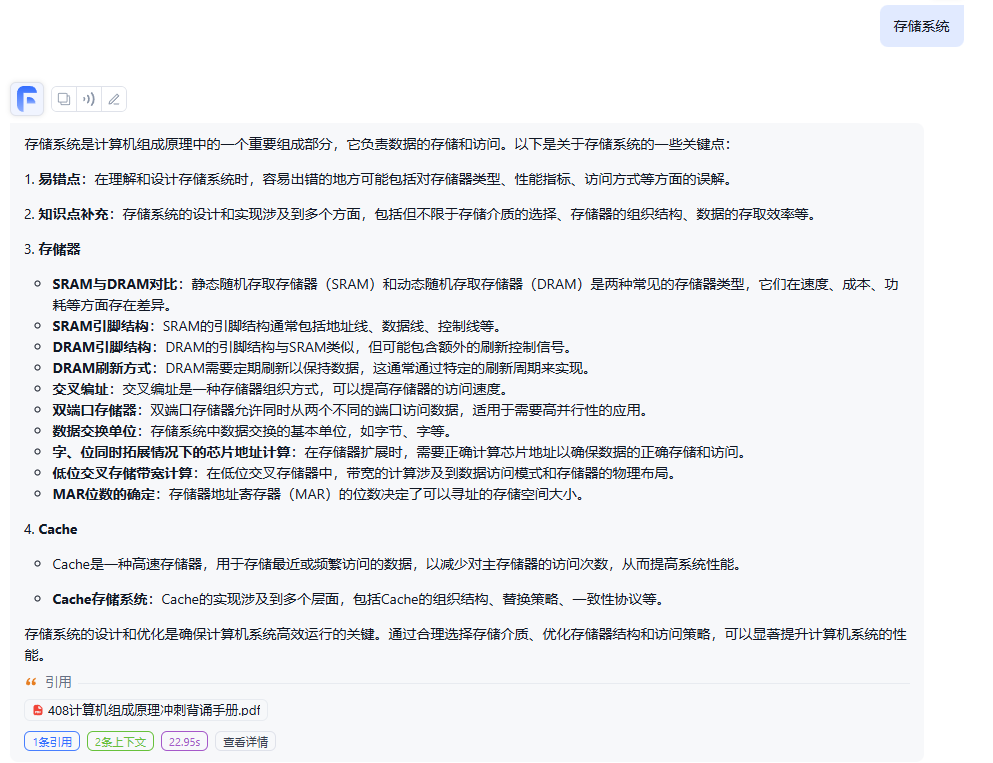本文主要是介绍pta数据结构树和图实验题,希望对大家解决编程问题提供一定的参考价值,需要的开发者们随着小编来一起学习吧!
先序输出叶结点 (15分)
本题要求按照先序遍历的顺序输出给定二叉树的叶结点。
函数接口定义:
void PreorderPrintLeaves( BinTree BT );其中BinTree结构定义如下:
typedef struct TNode *Position;
typedef Position BinTree;
struct TNode{ElementType Data;BinTree Left;BinTree Right;
};函数PreorderPrintLeaves应按照先序遍历的顺序输出给定二叉树BT的叶结点,格式为一个空格跟着一个字符。
裁判测试程序样例:
#include <stdio.h>
#include <stdlib.h>typedef char ElementType;
typedef struct TNode *Position;
typedef Position BinTree;
struct TNode{ElementType Data;BinTree Left;BinTree Right;
};BinTree CreatBinTree(); /* 实现细节忽略 */
void PreorderPrintLeaves( BinTree BT );int main()
{BinTree BT = CreatBinTree();printf("Leaf nodes are:");PreorderPrintLeaves(BT);printf("\n");return 0;
}
/* 你的代码将被嵌在这里 */输出样例(对于图中给出的树):

Leaf nodes are: D E H I
void PreorderPrintLeaves( BinTree BT )
{if(BT == NULL)return;//如果根节点为空,什么都不执行if(BT->Left == NULL && BT->Right == NULL)//如果一个节点既没有左孩子,又没有右孩子,说明是叶子节点 {printf(" %c", BT->Data);//题目要求:空格+字符 } PreorderPrintLeaves(BT->Left);//访问左孩子 PreorderPrintLeaves(BT->Right); //访问右孩子
}
邻接矩阵存储图的深度优先遍历 (20分)
试实现邻接矩阵存储图的深度优先遍历。
函数接口定义:
void DFS( MGraph Graph, Vertex V, void (*Visit)(Vertex) );其中MGraph是邻接矩阵存储的图,定义如下:
typedef struct GNode *PtrToGNode;
struct GNode{int Nv; /* 顶点数 */int Ne; /* 边数 */WeightType G[MaxVertexNum][MaxVertexNum]; /* 邻接矩阵 */
};
typedef PtrToGNode MGraph; /* 以邻接矩阵存储的图类型 */函数DFS应从第V个顶点出发递归地深度优先遍历图Graph,遍历时用裁判定义的函数Visit访问每个顶点。当访问邻接点时,要求按序号递增的顺序。题目保证V是图中的合法顶点。
裁判测试程序样例:
#include <stdio.h>typedef enum {false, true} bool;
#define MaxVertexNum 10 /* 最大顶点数设为10 */
#define INFINITY 65535 /* ∞设为双字节无符号整数的最大值65535*/
typedef int Vertex; /* 用顶点下标表示顶点,为整型 */
typedef int WeightType; /* 边的权值设为整型 */typedef struct GNode *PtrToGNode;
struct GNode{int Nv; /* 顶点数 */int Ne; /* 边数 */WeightType G[MaxVertexNum][MaxVertexNum]; /* 邻接矩阵 */
};
typedef PtrToGNode MGraph; /* 以邻接矩阵存储的图类型 */
bool Visited[MaxVertexNum]; /* 顶点的访问标记 */MGraph CreateGraph(); /* 创建图并且将Visited初始化为false;裁判实现,细节不表 */void Visit( Vertex V )
{printf(" %d", V);
}void DFS( MGraph Graph, Vertex V, void (*Visit)(Vertex) );int main()
{MGraph G;Vertex V;G = CreateGraph();scanf("%d", &V);printf("DFS from %d:", V);DFS(G, V, Visit);return 0;
}/* 你的代码将被嵌在这里 */输入样例:给定图如下

5输出样例:
DFS from 5: 5 1 3 0 2 4 6
void DFS( MGraph Graph, Vertex V, void (*Visit)(Vertex) )
{Visited[V] = true;//把当前节点标记为已访问 Visit(V);//输出当前节点 for(int i = 0; i < Graph->Nv; i++){if(Graph->G[V][i] == 1 && !Visited[i]){DFS(Graph, i, Visit);}}
}
邻接表存储图的广度优先遍历 (20分)
试实现邻接表存储图的广度优先遍历。
函数接口定义:
void BFS ( LGraph Graph, Vertex S, void (*Visit)(Vertex) );其中LGraph是邻接表存储的图,定义如下:
/* 邻接点的定义 */
typedef struct AdjVNode *PtrToAdjVNode;
struct AdjVNode{Vertex AdjV; /* 邻接点下标 */PtrToAdjVNode Next; /* 指向下一个邻接点的指针 */
};/* 顶点表头结点的定义 */
typedef struct Vnode{PtrToAdjVNode FirstEdge; /* 边表头指针 */
} AdjList[MaxVertexNum]; /* AdjList是邻接表类型 *//* 图结点的定义 */
typedef struct GNode *PtrToGNode;
struct GNode{ int Nv; /* 顶点数 */int Ne; /* 边数 */AdjList G; /* 邻接表 */
};
typedef PtrToGNode LGraph; /* 以邻接表方式存储的图类型 */函数BFS应从第S个顶点出发对邻接表存储的图Graph进行广度优先搜索,遍历时用裁判定义的函数Visit访问每个顶点。当访问邻接点时,要求按邻接表顺序访问。题目保证S是图中的合法顶点。
裁判测试程序样例:
#include <stdio.h>typedef enum {false, true} bool;
#define MaxVertexNum 10 /* 最大顶点数设为10 */
typedef int Vertex; /* 用顶点下标表示顶点,为整型 *//* 邻接点的定义 */
typedef struct AdjVNode *PtrToAdjVNode;
struct AdjVNode{Vertex AdjV; /* 邻接点下标 */PtrToAdjVNode Next; /* 指向下一个邻接点的指针 */
};/* 顶点表头结点的定义 */
typedef struct Vnode{PtrToAdjVNode FirstEdge; /* 边表头指针 */
} AdjList[MaxVertexNum]; /* AdjList是邻接表类型 *//* 图结点的定义 */
typedef struct GNode *PtrToGNode;
struct GNode{ int Nv; /* 顶点数 */int Ne; /* 边数 */AdjList G; /* 邻接表 */
};
typedef PtrToGNode LGraph; /* 以邻接表方式存储的图类型 */bool Visited[MaxVertexNum]; /* 顶点的访问标记 */LGraph CreateGraph(); /* 创建图并且将Visited初始化为false;裁判实现,细节不表 */void Visit( Vertex V )
{printf(" %d", V);
}void BFS ( LGraph Graph, Vertex S, void (*Visit)(Vertex) );int main()
{LGraph G;Vertex S;G = CreateGraph();scanf("%d", &S);printf("BFS from %d:", S);BFS(G, S, Visit);return 0;
}/* 你的代码将被嵌在这里 */输入样例:给定图如下

2输出样例:
BFS from 2: 2 0 3 5 4 1 6
void BFS ( LGraph Graph, Vertex S, void (*Visit)(Vertex) )
{int que[1000];int f = 0, r = 0;que[r++] = S;Visit(S);Visited[S] = true;while(f != r){PtrToAdjVNode tmp = Graph->G[que[f++]].FirstEdge;while(tmp){Vertex pos = tmp->AdjV;if(!Visited[pos]){Visited[pos] = true;Visit(pos);que[r++] = pos;}tmp = tmp->Next;} }
}
二叉树的遍历 (25分)
本题要求给定二叉树的4种遍历。
函数接口定义:
void InorderTraversal( BinTree BT );
void PreorderTraversal( BinTree BT );
void PostorderTraversal( BinTree BT );
void LevelorderTraversal( BinTree BT );其中BinTree结构定义如下:
typedef struct TNode *Position;
typedef Position BinTree;
struct TNode{ElementType Data;BinTree Left;BinTree Right;
};要求4个函数分别按照访问顺序打印出结点的内容,格式为一个空格跟着一个字符。
裁判测试程序样例:
#include <stdio.h>
#include <stdlib.h>typedef char ElementType;
typedef struct TNode *Position;
typedef Position BinTree;
struct TNode{ElementType Data;BinTree Left;BinTree Right;
};BinTree CreatBinTree(); /* 实现细节忽略 */
void InorderTraversal( BinTree BT );
void PreorderTraversal( BinTree BT );
void PostorderTraversal( BinTree BT );
void LevelorderTraversal( BinTree BT );int main()
{BinTree BT = CreatBinTree();printf("Inorder:"); InorderTraversal(BT); printf("\n");printf("Preorder:"); PreorderTraversal(BT); printf("\n");printf("Postorder:"); PostorderTraversal(BT); printf("\n");printf("Levelorder:"); LevelorderTraversal(BT); printf("\n");return 0;
}
/* 你的代码将被嵌在这里 */输出样例(对于图中给出的树):

Inorder: D B E F A G H C I
Preorder: A B D F E C G H I
Postorder: D E F B H G I C A
Levelorder: A B C D F G I E Hvoid InorderTraversal( BinTree BT )
{if(BT){InorderTraversal(BT->Left);printf(" %c", BT->Data);InorderTraversal(BT->Right);}
}
void PreorderTraversal( BinTree BT )
{if(BT){printf(" %c", BT->Data);PreorderTraversal(BT->Left);PreorderTraversal(BT->Right); }
}
void PostorderTraversal( BinTree BT )
{if(BT){PostorderTraversal(BT->Left);PostorderTraversal(BT->Right);printf(" %c", BT->Data);}
}
void LevelorderTraversal( BinTree BT )
{BinTree que[1000];int f = 0, r = 0;if(BT)que[r++] = BT;while(f != r){BinTree q = que[f++];printf(" %c", q->Data);if(q->Left)que[r++] = q->Left;if(q->Right)que[r++] = q->Right;}
}
树的遍历 (25分)
给定一棵二叉树的后序遍历和中序遍历,请你输出其层序遍历的序列。这里假设键值都是互不相等的正整数。
输入格式:
输入第一行给出一个正整数N(≤30),是二叉树中结点的个数。第二行给出其后序遍历序列。第三行给出其中序遍历序列。数字间以空格分隔。
输出格式:
在一行中输出该树的层序遍历的序列。数字间以1个空格分隔,行首尾不得有多余空格。
输入样例:
7
2 3 1 5 7 6 4
1 2 3 4 5 6 7输出样例:
4 1 6 3 5 7 2
#include<iostream>
using namespace std;
struct Node
{int data;Node* left;Node* right;
}*root;
int t;
int post[55], in[55];//输入的数组
void create(Node*& root, int l, int r)
{int flag = -1;for(int i = l; i <= r; i++){if(post[t] == in[i])//说明找到了根节点{flag = i;break;} }if(flag == -1)return;//没有找到根节点,什么也不执行root = new Node;root->data = in[flag];root->left = root->right = NULL;t--;//t保存的是后序的下标, 故--create(root->right, flag + 1, r);//已知中序和后序,先创建右子树,再创建左子树//已知前序和中序,先创建左子树,再创建右子树 create(root->left, l, flag - 1); }
void level(Node* root)
{Node* que[1000];int f = 0, r = 0;if(root)que[r++] = root;while(f != r){Node* q = que[f++];if(f > 1)cout<<" ";//控制输出空格 cout<<q->data;if(q->left)que[r++] = q->left;if(q->right)que[r++] = q->right;}
}
int main()
{root = NULL;int n;cin>>n;t = n - 1;for(int i = 0; i < n; i++)cin>>post[i];for(int i = 0; i < n; i++)cin>>in[i];create(root, 0, n -1);level(root);return 0;
}
还原二叉树 (25分)
给定一棵二叉树的先序遍历序列和中序遍历序列,要求计算该二叉树的高度。
输入格式:
输入首先给出正整数N(≤50),为树中结点总数。下面两行先后给出先序和中序遍历序列,均是长度为N的不包含重复英文字母(区别大小写)的字符串。
输出格式:
输出为一个整数,即该二叉树的高度。
输入样例:
9
ABDFGHIEC
FDHGIBEAC输出样例:
5
#include<iostream>
using namespace std;
struct Node
{int data;Node* left;Node* right;
}*root;
int t = 0;
char pre[55], in[55];//输入的数组
void create(Node*& root, int l, int r)
{int flag = -1;for(int i = l; i <= r; i++){if(pre[t] == in[i])//说明找到了根节点{flag = i;break;} }if(flag == -1)return;//没有找到根节点,什么也不执行root = new Node;root->data = in[flag];root->left = root->right = NULL;t++;//t保存的是前序的下标, 故++ create(root->left, l, flag - 1);create(root->right, flag + 1, r);//已知前序和中序,先创建左子树,再创建右子树 }
int height(Node* root)
{if(root == NULL)return 0;int m = height(root->left);int n = height(root->right);return m > n ? m + 1 : n + 1;
}
int main()
{root = NULL;int n;cin>>n;cin>>pre>>in;create(root, 0, n -1);cout<<height(root)<<endl;return 0;
}
根据后序和中序遍历输出先序遍历 (25分)
本题要求根据给定的一棵二叉树的后序遍历和中序遍历结果,输出该树的先序遍历结果。
输入格式:
第一行给出正整数N(≤30),是树中结点的个数。随后两行,每行给出N个整数,分别对应后序遍历和中序遍历结果,数字间以空格分隔。题目保证输入正确对应一棵二叉树。
输出格式:
在一行中输出Preorder: 以及该树的先序遍历结果。数字间有1个空格,行末不得有多余空格。
输入样例:
7
2 3 1 5 7 6 4
1 2 3 4 5 6 7输出样例:
Preorder: 4 1 3 2 6 5 7#include<iostream>
using namespace std;
struct Node
{int data;Node* left;Node* right;
}*root;
int t;
int post[55], in[55];//输入的数组
void create(Node*& root, int l, int r)
{int flag = -1;for(int i = l; i <= r; i++){if(post[t] == in[i])//说明找到了根节点{flag = i;break;} }if(flag == -1)return;//没有找到根节点,什么也不执行root = new Node;root->data = in[flag];root->left = root->right = NULL;t--;create(root->right, flag + 1, r);create(root->left, l, flag - 1); }
void Preorder(Node* root)
{if(root){printf(" %d", root->data);Preorder(root->left);Preorder(root->right);}
}
int main()
{root = NULL;int n;cin>>n;t = n - 1;for(int i = 0; i < n; i++)cin>>post[i];for(int i = 0; i < n; i++)cin>>in[i];create(root, 0, n -1);cout<<"Preorder:";Preorder(root);return 0;
}
二叉搜索树的结构 (30分)
二叉搜索树或者是一棵空树,或者是具有下列性质的二叉树: 若它的左子树不空,则左子树上所有结点的值均小于它的根结点的值;若它的右子树不空,则右子树上所有结点的值均大于它的根结点的值;它的左、右子树也分别为二叉搜索树。(摘自百度百科)
给定一系列互不相等的整数,将它们顺次插入一棵初始为空的二叉搜索树,然后对结果树的结构进行描述。你需要能判断给定的描述是否正确。例如将{ 2 4 1 3 0 }插入后,得到一棵二叉搜索树,则陈述句如“2是树的根”、“1和4是兄弟结点”、“3和0在同一层上”(指自顶向下的深度相同)、“2是4的双亲结点”、“3是4的左孩子”都是正确的;而“4是2的左孩子”、“1和3是兄弟结点”都是不正确的。
输入格式:
输入在第一行给出一个正整数N(≤100),随后一行给出N个互不相同的整数,数字间以空格分隔,要求将之顺次插入一棵初始为空的二叉搜索树。之后给出一个正整数M(≤100),随后M行,每行给出一句待判断的陈述句。陈述句有以下6种:
A is the root,即"A是树的根";A and B are siblings,即"A和B是兄弟结点";A is the parent of B,即"A是B的双亲结点";A is the left child of B,即"A是B的左孩子";A is the right child of B,即"A是B的右孩子";A and B are on the same level,即"A和B在同一层上"。
题目保证所有给定的整数都在整型范围内。
输出格式:
对每句陈述,如果正确则输出Yes,否则输出No,每句占一行。
输入样例:
5
2 4 1 3 0
8
2 is the root
1 and 4 are siblings
3 and 0 are on the same level
2 is the parent of 4
3 is the left child of 4
1 is the right child of 2
4 and 0 are on the same level
100 is the right child of 3输出样例:
Yes
Yes
Yes
Yes
Yes
No
No
No#include <bits/stdc++.h>
using namespace std;
struct BTNode
{int data; BTNode* left;BTNode* right;BTNode(int x):data(x),left(NULL),right(NULL){};
}*root;
int m,n,t,level[50000]; //全局变量
void CreateBSTree(BTNode*& root,int x)
{if(root == NULL)root = new BTNode(x);else if(root->data > x)CreateBSTree(root->left,x);else CreateBSTree(root->right,x);
}
void levelorder(BTNode* root)
{int front = 0,rear = 0;n = 1;BTNode* que[100000] = {};if(root)que[rear++] = root;while(front != rear && n <= 50000){BTNode* p = que[front++];if(p){level[n++] = p->data;que[rear++] = p->left;que[rear++] = p->right;}else{n++;rear += 2;}}
}
int height(BTNode* root,int x) //这里可以加上一句if(root == NULL)return 0;但我可以保证x一定存在于树中,所以不必判断
{if(root->data > x)return 1 + height(root->left,x);else if(root->data < x)return 1 + height(root->right,x);return 1;
}
void GetNum(char* str,int& a,int& b)
{int i = 0; //这里去掉对a的负数判断后依然可以ac,所以去掉了a的符号判断while(str[i] != ' ')a = (a * 10 + str[i++] - '0');bool flag = 0;for(;str[i];i++){if(str[i] >= '0' && str[i] <= '9')b = (b * 10 + str[i] - '0');if(str[i] == '-')flag = 1;}if(flag)b = -b;
}
int find(int x)
{for(int i = 1;i <= n;i++) if(level[i] == x)return i;return -INT_MAX;
}
int main()
{char str[100];for(int i = 0;i < 50000;i++)level[i] = -INT_MAX;cin >> n;for(int i = 0;i < n;i++){cin >> t; CreateBSTree(root,t);}levelorder(root);cin >> m;getchar();for(int i = 0;i < m;i++){int a = 0,b = 0;cin.getline(str,100);GetNum(str,a,b);int fa = find(a), fb = find(b);if(strstr(str,"root")){if(level[1] == a)cout << "Yes" << endl;else cout << "No" << endl;}else if(strstr(str,"siblings")){if(fa != -INT_MAX && fb != -INT_MAX && fa != fb && (fa / 2 == fb / 2))cout << "Yes" << endl;else cout << "No" << endl;}else if(strstr(str,"parent")){if(fa != -INT_MAX && fb != -INT_MAX && (fb / 2 == fa))cout << "Yes" << endl;else cout << "No" << endl;}else if(strstr(str,"left")){if(fa != -INT_MAX && fb != -INT_MAX && (fb * 2 == fa))cout << "Yes" << endl;else cout << "No" << endl;}else if(strstr(str,"right")){if(fa != -INT_MAX && fb != -INT_MAX && (fb * 2 + 1 == fa))cout << "Yes" << endl;else cout << "No" << endl;}else if(strstr(str,"same")){if(fa != -INT_MAX && fb != -INT_MAX && (height(root,a) == height(root,b)))cout << "Yes" << endl;else cout << "No" << endl;}}return 0;
}
这篇关于pta数据结构树和图实验题的文章就介绍到这儿,希望我们推荐的文章对编程师们有所帮助!









